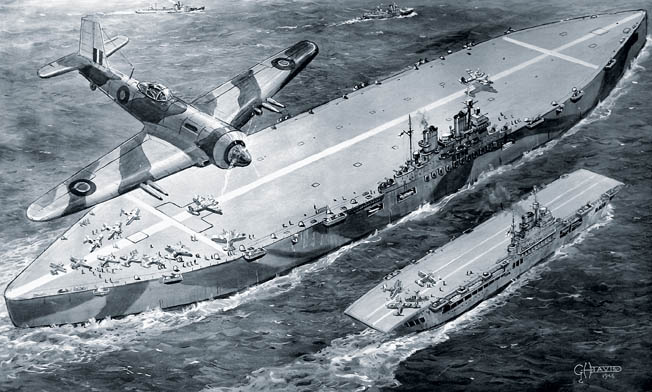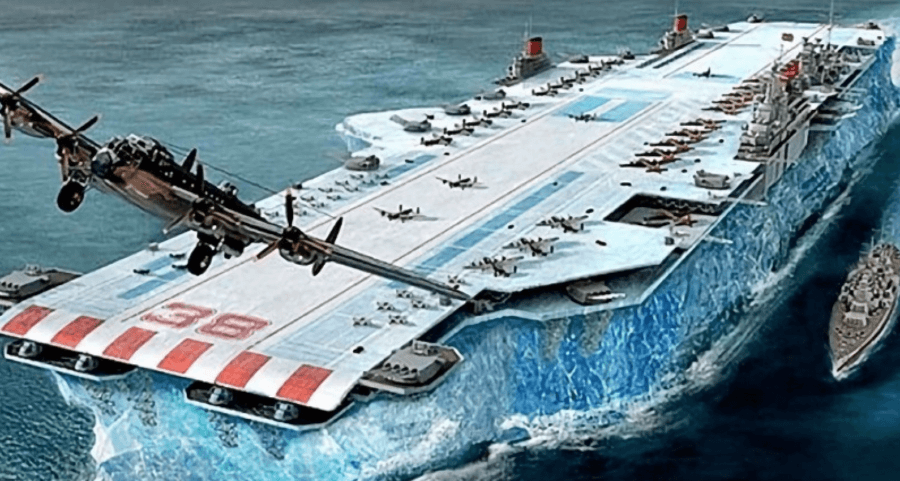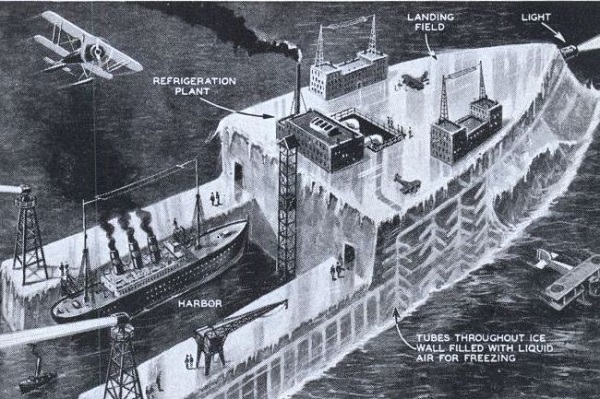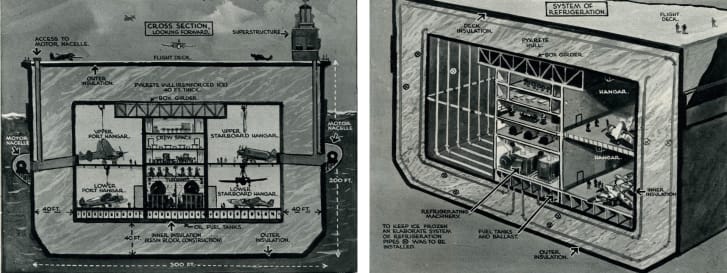What if, lets go crazy, Project Habbakuk: Britain's Secret Ice "Bergship" Aircraft Carrier
Jul 18, 2020 15:05:19 GMT
stevep likes this
Post by lordroel on Jul 18, 2020 15:05:19 GMT
What if, lets go crazy, Project Habbakuk: Britain's Secret Ice "Bergship" Aircraft Carrier
Image: Illustration showing the top secret design for HMS ‘Habbakuk‘ (centre), a giant aircraft-carrier built of ice and wood pulp, which was proposed as a secret weapon in the Second World War. This project was put forward by Geoffrey Pyke in 1942, but was never built as the practicalities involved were too much for the British war effort. The ‘Habbakuk’ is shown next to HMS ‘Indefatigable‘ (right), a large British aircraft-carrier built of conventional materials. February 3, 1946.

Image II design

British Prime Minister Winston Churchill had an idea. By late 1942, Nazi U-boats ravaged Allied merchant shipping in the North Atlantic. In desperation Churchill conceived one far-fetched remedy, taking nature’s own massive icebergs and smoothing them over to make landing strips in the North Atlantic to provide air cover for convoys.
Churchill’s vision did not come about, but Mountbatten grew to appreciate Habakkuk more and more. The time arrived when he enthusiastically rushed off to share it with Churchill at his private residence. He brought along a chunk of pykrete with the thought to fill Churchill’s bathtub with hot water and see how long it took the pykrete to melt. The block of modified ice seemed to float for hours unchanged by heated water.
Churchill was awestruck. He wanted a man-made iceberg aircraft carrier 2,000 feet long, 300 feet wide, with a depth of 200 feet holding a draft of 150 feet. Its hull and bottom would measure a 40-foot thickness of pykrete. Such a vessel would supposedly be impregnable to shells and torpedoes. It was meant to withstand North Atlantic waves towering 50 feet. It would carry 200 single-engine British fighter planes as well as 100 British twin-engine bombers. The seafaring range would be nothing less than 7,000 miles doing at least seven knots.
Image: Construction concept for an ice-based aircraft carrier

The vessel’s infrastructure would contain a massive refrigeration system that would constantly moderate the ship’s structural temperature. Its final tonnage of ice, steel, wood, and other materials came in at 2.2 million tons. In comparison, the liner Queen Elizabeth sailed at 83,600 tons. The most fascinating aspect of it all was that the vessel could regenerate parts of itself. Even if significant surface damage was incurred, it was a simple fix. Just mix more pykrete solution and apply until frozen in place. There would be a few problems in working out cooling systems for electric motors and steering. All Churchill had to say on those facets was for the Project Habakkuk team to resolve such issues.
Churchill saw great hope for an answer to the Nazi U-boat menace. He also hoped the project would develop into a vessel capable of blockading enemy ports and into a large floating dock.
Image: Project Habakkuk model sections and cutaways

On August 19, 1944, during planning for Operation Overlord, the Allied invasion of Nazi-occupied Europe, Mountbatten took that opportunity to request of General Sir Alan Brooke time to present Project Habakkuk and the wonders of pykrete. Mountbatten took center stage and explained the makings of pykrete and the possibility of a 2.2 million ton iceberg aircraft carrier. He produced two square chunks of ice. One was untreated ice. The other was pykrete. He announced he would fire his pistol into each chunk.
Those in the room hurriedly lined up behind Mountbatten. One bullet fired into the regular ice block shattered and sent ice shrapnel flying around the room. Firing into the pykrete sent the bullet ricocheting across the room. One fragment went through a pants leg of an officer with no injury to him. Another spectator had a spent bullet fragment harmlessly bounce off his shoulder.
The only real injury came to U.S. Army Air Forces chief Henry “Hap” Arnold. At Mountbatten’s invitation, he took a hatchet and pounded on the pykrete. The whacks literally bounced back, jarring his arm and shoulder enough to cause a pained yelp. Other than an insignificant indention and a few scratches, the pykrete remained unscathed. Americans were somewhat impressed with the display but not thoroughly sold on Project Habakkuk, which was relocated to Canada for further research and development.
By late 1943, an eight-man Habakkuk team set up shop at Patricia Lake near Jasper, Alberta, Canada. The elevated mountainous site was removed from the hustle and bustle of crowds. A floating workshop was built on top of the lake. The wooden structure measured 60 feet long, 30 feet wide, and 20 feet high. The air conditioning system was powered by a one-horsepower engine.
It was envisioned that a completed vessel of desired measurements would require 300,000 tons of wood pulp, 25,000 tons of fireboard insulation, and at least 10,000 tons of steel. Just to see if such an object would float, a prototype was made. It came in at 60 feet long and 30 feet wide and weighing 1,000 tons, and it did float.
Image: Detailed diagram of pykrete hull and refrigeration ducts for proposed ship

But Project Habakkuk never got any further than that. It was continually challenged by both British and American skeptics. U.S. war planners decided to save steel for traditional aircraft carriers. As with anything in its research and development phase, cost overruns plagued the effort. The success of the Normandy invasion and a reversal of fortune in the Battle of the Atlantic also doomed Project Habakkuk.
Geoffrey Pyke carried on with his grand designs, which ended up going nowhere. One of his last great visions was an elongated pneumatic tube attached to troop carrier ships to land soldiers on Japanese-held islands. That idea failed on paper.
After the war, Pyke carried on with his peculiar habits while writing, researching, and planning. It seems most of his energy was channeled into writing. On February 21, 1948, at age 54, Pyke was found dead by his landlady. The cause of death was an intentional sleeping pill overdose. He was still writing while fading away into death. The further he lapsed, the more scrawled the writing. It seemed he was approaching a topic even Albert Einstein had yet to ponder. Pyke may have been plotting a mathematical formula of the time-space continuum.
YouTube (Drachinifel - HMS Habakkuk)
Image: Illustration showing the top secret design for HMS ‘Habbakuk‘ (centre), a giant aircraft-carrier built of ice and wood pulp, which was proposed as a secret weapon in the Second World War. This project was put forward by Geoffrey Pyke in 1942, but was never built as the practicalities involved were too much for the British war effort. The ‘Habbakuk’ is shown next to HMS ‘Indefatigable‘ (right), a large British aircraft-carrier built of conventional materials. February 3, 1946.

Image II design

British Prime Minister Winston Churchill had an idea. By late 1942, Nazi U-boats ravaged Allied merchant shipping in the North Atlantic. In desperation Churchill conceived one far-fetched remedy, taking nature’s own massive icebergs and smoothing them over to make landing strips in the North Atlantic to provide air cover for convoys.
Churchill’s vision did not come about, but Mountbatten grew to appreciate Habakkuk more and more. The time arrived when he enthusiastically rushed off to share it with Churchill at his private residence. He brought along a chunk of pykrete with the thought to fill Churchill’s bathtub with hot water and see how long it took the pykrete to melt. The block of modified ice seemed to float for hours unchanged by heated water.
Churchill was awestruck. He wanted a man-made iceberg aircraft carrier 2,000 feet long, 300 feet wide, with a depth of 200 feet holding a draft of 150 feet. Its hull and bottom would measure a 40-foot thickness of pykrete. Such a vessel would supposedly be impregnable to shells and torpedoes. It was meant to withstand North Atlantic waves towering 50 feet. It would carry 200 single-engine British fighter planes as well as 100 British twin-engine bombers. The seafaring range would be nothing less than 7,000 miles doing at least seven knots.
Image: Construction concept for an ice-based aircraft carrier

The vessel’s infrastructure would contain a massive refrigeration system that would constantly moderate the ship’s structural temperature. Its final tonnage of ice, steel, wood, and other materials came in at 2.2 million tons. In comparison, the liner Queen Elizabeth sailed at 83,600 tons. The most fascinating aspect of it all was that the vessel could regenerate parts of itself. Even if significant surface damage was incurred, it was a simple fix. Just mix more pykrete solution and apply until frozen in place. There would be a few problems in working out cooling systems for electric motors and steering. All Churchill had to say on those facets was for the Project Habakkuk team to resolve such issues.
Churchill saw great hope for an answer to the Nazi U-boat menace. He also hoped the project would develop into a vessel capable of blockading enemy ports and into a large floating dock.
Image: Project Habakkuk model sections and cutaways

On August 19, 1944, during planning for Operation Overlord, the Allied invasion of Nazi-occupied Europe, Mountbatten took that opportunity to request of General Sir Alan Brooke time to present Project Habakkuk and the wonders of pykrete. Mountbatten took center stage and explained the makings of pykrete and the possibility of a 2.2 million ton iceberg aircraft carrier. He produced two square chunks of ice. One was untreated ice. The other was pykrete. He announced he would fire his pistol into each chunk.
Those in the room hurriedly lined up behind Mountbatten. One bullet fired into the regular ice block shattered and sent ice shrapnel flying around the room. Firing into the pykrete sent the bullet ricocheting across the room. One fragment went through a pants leg of an officer with no injury to him. Another spectator had a spent bullet fragment harmlessly bounce off his shoulder.
The only real injury came to U.S. Army Air Forces chief Henry “Hap” Arnold. At Mountbatten’s invitation, he took a hatchet and pounded on the pykrete. The whacks literally bounced back, jarring his arm and shoulder enough to cause a pained yelp. Other than an insignificant indention and a few scratches, the pykrete remained unscathed. Americans were somewhat impressed with the display but not thoroughly sold on Project Habakkuk, which was relocated to Canada for further research and development.
By late 1943, an eight-man Habakkuk team set up shop at Patricia Lake near Jasper, Alberta, Canada. The elevated mountainous site was removed from the hustle and bustle of crowds. A floating workshop was built on top of the lake. The wooden structure measured 60 feet long, 30 feet wide, and 20 feet high. The air conditioning system was powered by a one-horsepower engine.
It was envisioned that a completed vessel of desired measurements would require 300,000 tons of wood pulp, 25,000 tons of fireboard insulation, and at least 10,000 tons of steel. Just to see if such an object would float, a prototype was made. It came in at 60 feet long and 30 feet wide and weighing 1,000 tons, and it did float.
Image: Detailed diagram of pykrete hull and refrigeration ducts for proposed ship

But Project Habakkuk never got any further than that. It was continually challenged by both British and American skeptics. U.S. war planners decided to save steel for traditional aircraft carriers. As with anything in its research and development phase, cost overruns plagued the effort. The success of the Normandy invasion and a reversal of fortune in the Battle of the Atlantic also doomed Project Habakkuk.
Geoffrey Pyke carried on with his grand designs, which ended up going nowhere. One of his last great visions was an elongated pneumatic tube attached to troop carrier ships to land soldiers on Japanese-held islands. That idea failed on paper.
After the war, Pyke carried on with his peculiar habits while writing, researching, and planning. It seems most of his energy was channeled into writing. On February 21, 1948, at age 54, Pyke was found dead by his landlady. The cause of death was an intentional sleeping pill overdose. He was still writing while fading away into death. The further he lapsed, the more scrawled the writing. It seemed he was approaching a topic even Albert Einstein had yet to ponder. Pyke may have been plotting a mathematical formula of the time-space continuum.
YouTube (Drachinifel - HMS Habakkuk)





 - and setting up such a craft, coupled with the propulsion requirements and manpower could be greater issues however.
- and setting up such a craft, coupled with the propulsion requirements and manpower could be greater issues however. Would think the N Atlantic would be a markedly higher priority as that was the only battle ground that could have made WWII look unwinnable once the US joined the war and before it was known that nukes were practical.
Would think the N Atlantic would be a markedly higher priority as that was the only battle ground that could have made WWII look unwinnable once the US joined the war and before it was known that nukes were practical.
